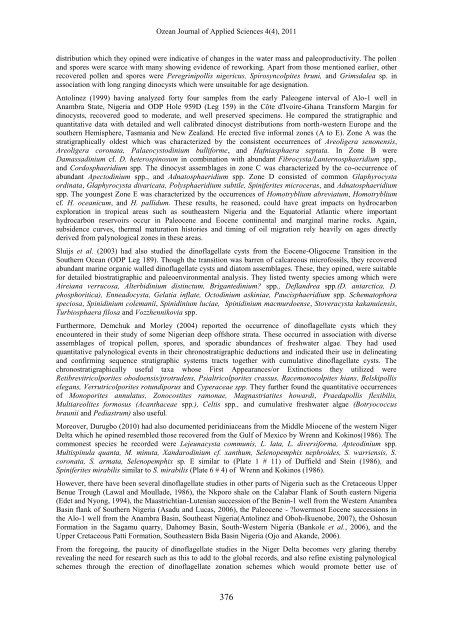download current issue - Ozean Publications
download current issue - Ozean Publications
download current issue - Ozean Publications
You also want an ePaper? Increase the reach of your titles
YUMPU automatically turns print PDFs into web optimized ePapers that Google loves.
<strong>Ozean</strong> Journal of Applied Sciences 4(4), 2011<br />
distribution which they opined were indicative of changes in the water mass and paleoproductivity. The pollen<br />
and spores were scarce with many showing evidence of reworking. Apart from those mentioned earlier, other<br />
recovered pollen and spores were Peregrinipollis nigericus, Spirosyncolpites bruni, and Grimsdalea sp. in<br />
association with long ranging dinocysts which were unsuitable for age designation.<br />
Antolinez (1999) having analyzed forty four samples from the early Paleogene interval of Alo-1 well in<br />
Anambra State, Nigeria and ODP Hole 959D (Leg 159) in the Côte d'Ivoire-Ghana Transform Margin for<br />
dinocysts, recovered good to moderate, and well preserved specimens. He compared the stratigraphic and<br />
quantitative data with detailed and well calibrated dinocyst distributions from north-western Europe and the<br />
southern Hemisphere, Tasmania and New Zealand. He erected five informal zones (A to E). Zone A was the<br />
stratigraphically oldest which was characterized by the consistent occurrences of Areoligera senonensis,<br />
Areoligera coronata, Palaeocystodinium bulliforme, and Hafniasphaera septata. In Zone B were<br />
Damassadinium cf. D. heterospinosum in combination with abundant Fibrocysta/Lanternosphaeridium spp.,<br />
and Cordosphaeridium spp. The dinocyst assemblages in zone C was characterized by the co-occurrence of<br />
abundant Apectodinium spp., and Adnatosphaeridium spp. Zone D consisted of common Glaphyrocysta<br />
ordinata, Glaphyrocysta divaricata, Polysphaeridium subtile, Spiniferites microceras, and Adnatosphaeridium<br />
spp. The youngest Zone E was characterized by the occurrences of Homotryblium abreviatum, Homotryblium<br />
cf. H. oceanicum, and H. pallidum. These results, he reasoned, could have great impacts on hydrocarbon<br />
exploration in tropical areas such as southeastern Nigeria and the Equatorial Atlantic where important<br />
hydrocarbon reservoirs occur in Paleocene and Eocene continental and marginal marine rocks. Again,<br />
subsidence curves, thermal maturation histories and timing of oil migration rely heavily on ages directly<br />
derived from palynological zones in these areas.<br />
Sluijs et al. (2003) had also studied the dinoflagellate cysts from the Eocene-Oligocene Transition in the<br />
Southern Ocean (ODP Leg 189). Though the transition was barren of calcareous microfossils, they recovered<br />
abundant marine organic walled dinoflagellate cysts and diatom assemblages. These, they opined, were suitable<br />
for detailed biostratigraphic and paleoenvironmental analysis. They listed twenty species among which were<br />
Aireiana verrucosa, Alterbidinium distinctum, Brigantedinium spp., Deflandrea spp.(D. antarctica, D.<br />
phosphoritica), Enneadocysta, Gelatia inflate, Octodinium askiniae, Paucisphaeridium spp. Schematophora<br />
speciosa, Spinidinium colemanii, Spinidinium luciae, Spinidinium macmurdoense, Stoveracysta kakanuiensis,<br />
Turbiosphaera filosa and Vozzhennikovia spp.<br />
Furthermore, Demchuk and Morley (2004) reported the occurrence of dinoflagellate cysts which they<br />
encountered in their study of some Nigerian deep offshore strata. These occurred in association with diverse<br />
assemblages of tropical pollen, spores, and sporadic abundances of freshwater algae. They had used<br />
quantitative palynological events in their chronostratigraphic deductions and indicated their use in delineating<br />
and confirming sequence stratigraphic systems tracts together with cumulative dinoflagellate cysts. The<br />
chronostratigraphically useful taxa whose First Appearances/or Extinctions they utilized were<br />
Retibrevitricolporites obodoensis/protrudens, Psialtricolporites crassus, Racemonocolpites hians, Belskipollis<br />
elegans, Verrutricolporites rotundiporus and Cyperaceae spp. They further found the quantitative occurrences<br />
of Monoporites annulatus, Zonocostites ramonae, Magnastriatites howardi, Praedapollis flexibilis,<br />
Multiareolites formosus (Acanthaceae spp.), Celtis spp., and cumulative freshwater algae (Botryococcus<br />
braunii and Pediastrum) also useful.<br />
Moreover, Durugbo (2010) had also documented peridiniaceans from the Middle Miocene of the western Niger<br />
Delta which he opined resembled those recovered from the Gulf of Mexico by Wrenn and Kokinos(1986). The<br />
commonest species he recorded were Lejeunacysta communis, L. lata, L. diversiforma, Apteodinium spp.<br />
Multispinula quanta, M. minuta, Xandarodinium cf. xanthum, Selenopemphix nephroides, S. warriensis, S.<br />
coronata, S. armata, Selenopemphix sp. E similar to (Plate 1 # 11) of Duffield and Stein (1986), and<br />
Spiniferites mirabilis similar to S. mirabilis (Plate 6 # 4) of Wrenn and Kokinos (1986).<br />
However, there have been several dinoflagellate studies in other parts of Nigeria such as the Cretaceous Upper<br />
Benue Trough (Lawal and Moullade, 1986), the Nkporo shale on the Calabar Flank of South eastern Nigeria<br />
(Edet and Nyong, 1994), the Maastrichtian-Lutenian succession of the Benin-1 well from the Western Anambra<br />
Basin flank of Southern Nigeria (Asadu and Lucas, 2006), the Paleocene - lowermost Eocene successions in<br />
the Alo-1 well from the Anambra Basin, Southeast Nigeria(Antolinez and Oboh-Ikuenobe, 2007), the Oshosun<br />
Formation in the Sagamu quarry, Dahomey Basin, South-Western Nigeria (Bankole et al., 2006), and the<br />
Upper Cretaceous Patti Formation, Southeastern Bida Basin Nigeria (Ojo and Akande, 2006).<br />
From the foregoing, the paucity of dinoflagellate studies in the Niger Delta becomes very glaring thereby<br />
revealing the need for research such as this to add to the global records, and also refine existing palynological<br />
schemes through the erection of dinoflagellate zonation schemes which would promote better use of<br />
376

















